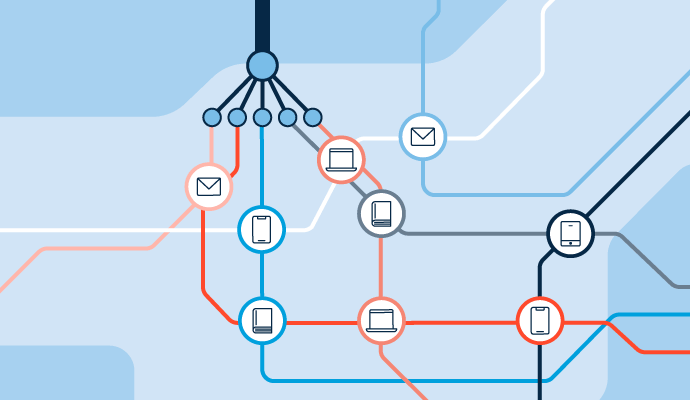December 13, 2021
.jpg?width=400&height=150&name=G2Headshots_Aayushi_Sanghavi_ZOE1415-Edit%20(1).jpg) by Aayushi Sanghavi / December 13, 2021
by Aayushi Sanghavi / December 13, 2021

Consistency is the key to everything.
Customer experience is, and must be, at the forefront of any business activity. As businesses shift their focus on investing in multiple customer communication channels, now more than ever it’s important to optimize these fragmented conversations for a single brand voice.
Omnichannel communication is a term we’ve all heard when it comes to creating seamless customer experiences across different mediums.
The best way to start your omnichannel strategy is by leveraging customer communication management software to enable cohesive communication and strong customer relationships in real-time.
Omnichannel, or omni channel, communication unifies the customer experience (CX) across different channels, such as websites, mobile apps, social media, and phone calls. It can be thought of as a single-point system used for optimizing interactions collectively regardless of the channel used.
Think about all the different ways you interact with your customers, whether it’s through blogs, live chats, social media, or even catalogs. Providing a seamless customer experience across different platforms can be hard to achieve. Omni channel communication, however, allows for easy access and migration without disrupting the customer journey.
You’ve likely heard the terms omnichannel and multi-channel used interchangeably. But the truth is, there are distinct differences between the two strategies.
Omnichannel communication views the brand from the customer’s perspective. Every customer interaction is aligned with the messaging and objectives of the company, regardless of the communication channel. Omnichannel systems also collate customer data insights from every platform, which helps understand customer purchasing behavior.
Ensuring your customers have a consistent experience at every touchpoint takes effort and shows you’re invested in connecting with them. In turn, this boosts loyalty, satisfaction and reduces customer churn.
On the other hand, multichannel communication simply refers to using several channels to have customer service conversations. This approach is used by most modern businesses to engage with customers and has unique brand positioning across different channels.
While multichannel communication is a great way to connect with customers on their favorite platforms, the channels can often be disconnected, leading to confusion and poor customer experience.
So what does all this really mean? Here’s an easy way to remember: Both omnichannel and multichannel communication consist of multiple channels, but multichannel communication may not necessarily be part of an omnichannel system.
Now that the tongue twister’s out of the way, take a look at this table to understand why you shouldn’t use the two terms interchangeably.
| Omnichannel communication | Multichannel communication | |
| Primary focus | Customer | Channel |
| Customer experience | Consistent experience across channels | Customer experience is channel-centric |
| Data and insights | Unifies customer touchpoints and data | Touchpoints are often disconnected and fragmented |
| Decision making | Faster decision-making based on customer behavior | Ambiguity in decision-making |
| Customer relationships | Relationships are built strategically | A tactical approach is used to form relationships |
| Response time | Better response time | Slow response time due to unoptimized channels |
By design, humans are hesitant toward change. We like the concept of familiarity and knowing what to expect when moving between conversations.
Omnichannel communication does just that. It focuses on creating an experience that’s convenient and easy to acquaint with, providing a single face in the presence of multiple communication avenues.
Omnichannel communication is just another word for consistent and seamless customer service communication.
Whether you have an e-commerce business or a brick-and-mortar store, your communication strategy must be unified. Customers should shift from online to offline channels with ease and experience high-quality service at all touchpoints.
of customers expect consistency in their interactions with different departments.
Source: Salesforce
With the vast array of communication channels available, it’s difficult to know exactly which ones your customers want to be contacted on. How do you solve this? Analysis! When you understand the needs of your specific audience and how they use online and offline channels, you can better integrate these channels under one system.
For example, customers are more likely to leave reviews on review sites and customer forums, while product queries generally come through phone calls or emails. Similarly, customers expect automotive companies to provide a consistent experience across all channels, from television commercials to physical showrooms.
Understanding your customers’ relationship with your business is crucial. Make use of insights from omnichannel platforms to keep the customer moving along the journey and create a process based on clear and transparent communication.
Multitasking has become a way of life. Let's be honest, when was the last time you were in a Zoom meeting and didn't respond to a chat or check your email?
The pace of life is accelerating and customers want simple, effective, and timely responses to their questions. Everything is on-demand and companies that recognize and adapt to these intent-rich preferences are playing the long game.
But to cope with changing customer needs, businesses need to invest in suitable customer support tools for specialized channels.
Visual engagement tools, live chat with customer service reps (CSRs), 24/7 help chatbots, and self-service options enable you to move along the customer communication journey and resolve issues with minimal support tickets and maximum engagement.
Omnichannel customer communication promotes both proactive response time and micro-personalization across desired channels. Businesses that leverage omnichannel strategies use data as a driving factor in their decision-making, such as prior customer history, product purchases, reviews, as well as preferred modes of communication.
Omnichannel communication unifies customer conversations to help companies analyze interaction history and refine online and offline customer experiences. These metrics are updated in real-time to improve the customer experience.
Customer communication technology and management have evolved with easy-to-implement tools such as customer relationship software (CRM), collaborative processes, and advanced cloud infrastructure for data storage.
One of the biggest advantages of omnichannel communication is integrating disparate communications into a single system with centralized customer insights. These include enriched information about the customer and their individual interactions across channels.
An omnichannel system also provides instant access to the complete history and context of the customer by auto-populating demographic and firmographic details. This buyer information can then be used to optimize current and future customer conversations.
It’s difficult to keep track of the different channels and the ways each of them handles alerts.
Omnichannel platforms work on behavioral data which reduces the miscommunication gap between customer service representatives and consumers. Because these insights are based on user behavior, they can be tracked and automated to trigger via emails, text messages, or push notifications.
Organizations often overlook a simple fact: customer service reps are their first true customers. Businesses that have simpler communication methods have a higher chance of effectively engaging their employees, which leads to efficient communication between your reps and your customers.
Employee attrition rates are just as important as customer retention rates when it comes to creating a positive employee experience. Empower your CSRs with personal dashboards and provide them with key metrics to help them stay aligned with customer success goals.
An omnichannel communication strategy improves customer support agents’ jobs by unifying several touchpoints into easy-to-understand data. This reduces complexity and back-and-forth conversations, enabling CSRs to have quick solutions at the first touchpoint.
Communication must be clear, concise, and convenient. Omnichannel communication accomplishes all three by providing customers the chance to interact on their preferred touchpoint – without having to think twice about the CX when switching to another medium.
Customers want convenience and a high-quality experience. An integrated communication model provides numerous options and a unified communication line to boost customer satisfaction and retention.
You’d be surprised at how many customers are willing to switch to a competing business after just one frustrated interaction. No one wants to hold the line for hours in search of a solution. When average response time decreases, resources can be managed efficiently and support teams are not overwhelmed with tickets.
To accelerate your response time, invest in tools that provide answers to frequently asked questions (FAQs) and 24/7 customer support for a smoother experience.
It’s essential to have a strong presence on the channels your customers use most. You can simplify this process by learning more about your target audience and their communication preferences. Real-time engagement is the cherry on top of omnichannel communication.
There’s so much more to customer communication than just investing in a hundred different channels. It all comes down to creating a system that is centralized, holistic, and ultimately unifies customer needs with business goals.
Like any process, omnichannel communication is constantly evolving and must be adapted to fit into your company’s strategy. Understanding the omnichannel customer will significantly impact both retention and revenue.
Paying attention to the way you communicate with your customers is the first step to optimizing customer relations. Learn about customer communication management for streamlined conversations.
Aayushi Sanghavi is a Campaign Coordinator at G2 for the Content and SEO teams at G2 and is exploring her interests in project management and process optimization. Previously, she has written for the Customer Service and Tech Verticals space. In her free time, she volunteers at animal shelters, dances, or attempts to learn a new language.
Multi-channel marketing allows you to engage with your audience where they are, all at once.
 by Sagar Joshi
by Sagar Joshi
Customer experience has become one of the most important factors that determine the long-term...
 by Marilia Dimitriou
by Marilia Dimitriou
Ever added something to your Amazon cart on your phone, then finished the purchase on your...
 by Alyssa Towns
by Alyssa Towns
Multi-channel marketing allows you to engage with your audience where they are, all at once.
 by Sagar Joshi
by Sagar Joshi
Customer experience has become one of the most important factors that determine the long-term...
 by Marilia Dimitriou
by Marilia Dimitriou


